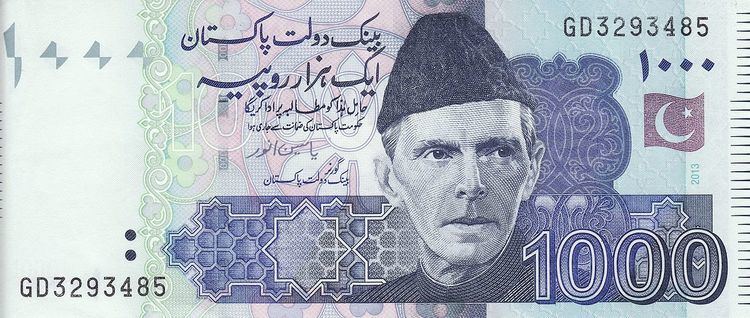Code PKR Exponent 2 Nickname Rupayya , Paisay | Number 586 ⁄100 Paisa (not used) | |
 | ||
Freq. used 10, 20, 50, 100, 500, 1000 Rupees | ||
The Pakistani rupee (Urdu: روپیہ / ALA-LC: Rūpiyah; sign: ₨; code: PKR) is the currency of Pakistan. The issuance of the currency is controlled by the State Bank of Pakistan, the central bank of the country. The most commonly used symbol for the rupee is Rs, used on receipts when purchasing goods and services.
Contents
In Pakistan, the rupee is also spelled as "rupees", "rupaya" or "rupaye". As standard in Pakistani English, large values of rupees are counted in terms of thousands, lakh (100 thousand) and crore (10 million), 1 Arab (1 billion), 1 Kharab (100 billion).
History
The word rūpiya is derived from the Sanskrit word rūpya, which means "wrought silver, a coin of silver", in origin an adjective meaning "shapely", with a more specific meaning of "stamped, impressed", whence "coin". It is` derived from the noun rūpa "shape, likeness, image". Rūpaya was used to denote the coin introduced by Sher Shah Suri during his reign from 1540 to 1545 CE.
The Pakistani rupee was put into circulation in Pakistan after the dissolution of the British Raj in 1947. Initially, Pakistan used British Indian coins and notes simply over-stamped with "Pakistan". New coins and banknotes were issued in 1948. Like the Indian rupee, it was originally divided into 16 annas, each of 4 pice or 12 pie. The currency was decimalised on 1 January 1961, with the rupee subdivided into 100 pice, renamed (in English) paise (singular paisa) later the same year. However, coins denominated in paise have not been issued since 1994.
=
In 1948, coins were introduced in denominations of 1 pice, 1⁄2, 1 and 2 annas, 1⁄4, 1⁄2 and 1 rupee. 1 pie coins were added in 1951. In 1961, coins for 1, 5 and 10 pice were issued, followed later the same year by 1 paisa, 5 and 10 paise coins. In 1963, 10 and 25 paise coins were introduced, followed by 2 paise the next year. 1 rupee coins were reintroduced in 1979, followed by 2 rupees in 1998 and 5 rupees in 2002. 2 paise coins were last minted in 1976, with 1 paisa coins ceasing production in 1979. The 5, 10, 25 and 50 paise all ceased production in 1996. There are two variations of 2 rupee coins; most have clouds above the Badshahi Masjid but many don't. The one and two rupee coins were changed to aluminium in 2007.
Paisa coins ceased to be legal tender in 2013, leaving Rs. 1 coin as the minimum legal tender. On 15 October 2015, the Pakistani government introduced a revised 5 rupee coin with a reduced size and weight and having a golden color, being made from a composition of copper-nickel-zinc, and also a Rs.10 coin was introduced in circulation.
Exchange rate
The rupee was pegged to the British pound until 1982, when the government of General Zia-ul-Haq changed it to managed float. As a result, the rupee devalued by 38.5% between 1982–83 and 1987–88 and the cost of importing raw materials increased rapidly, causing pressure on Pakistani finances and damaging much of the industrial base. The Pakistani rupee depreciated against the United States dollar until the turn of the century, when Pakistan's large current-account surplus pushed the value of the rupee up versus the dollar. The State Bank of Pakistan then stabilized the exchange rate by lowering interest rates and buying dollars, in order to preserve the country's export competitiveness.
2008 was termed a disastrous year for the rupee after the elections and until August 2008 it had lost 23% of its value since December 2007 to a record low of 79.2 against the US dollar. The major reasons for this depreciation, a huge current and trade accounts deficits, had been built up since the credit boom in Pakistan post 2002. Due to rising militancy in the NWFP and FATA areas FDI began to fall and the structural problems of the balance of payment where exposed; a disastrous situation occurred where foreign reserves fell to as low as $2 billion. However, by February 2011 Forex reserves had recovered and set a new record of $17 billion. Of that $17 billion, more than $10 billion was borrowed money with interest applicable. In February 2016 Pakistani rupee was Rs 104.66 against US dollar.
